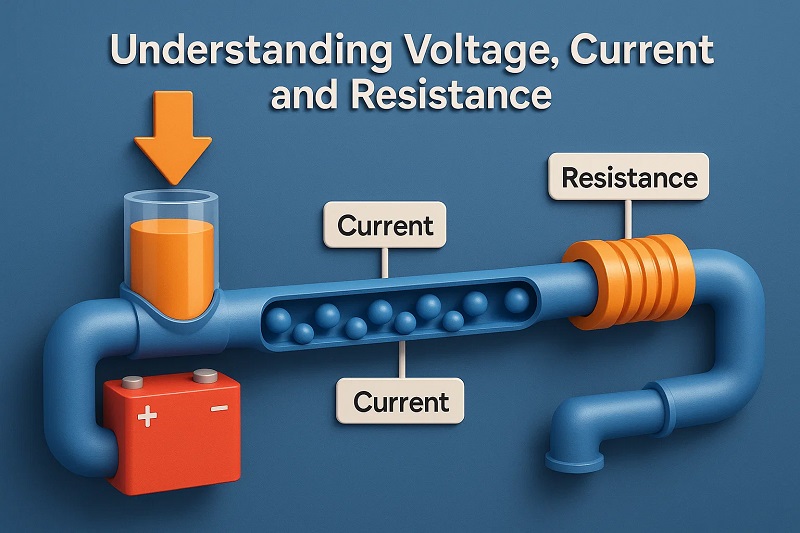⚡Understanding Voltage, Current, and Resistance: A Beginner’s Guide.
Electricity powers our homes, devices, and lives—but to truly understand how it works, you must first learn three fundamental concepts: voltage, current, and resistance. These three are the foundation of all electrical systems, and they’re linked by one of the most important equations in electronics: Ohm’s Law.
In this beginner-friendly guide, we’ll break it all down simply—with real-world comparisons and examples.
Table of Contents
What Is Voltage?
What Is Current?
What Is Resistance?
Ohm’s Law: The Connection Between V, I, and R
Real-World Examples
Why These Concepts Matter
FAQs
Conclusion
1. What Is Voltage?
Voltage is the electrical potential difference between two points. It’s what pushes electric charges (electrons) through a conductor—just like pressure pushes water through a pipe.
Symbol: V
Unit: Volt (V)
Think of it like water pressure in a hose
Measured using: A voltmeter
Example: A 9V battery has 9 volts of pressure to push current through a circuit.
2. What Is Current?
Current is the flow of electric charge—specifically, the flow of electrons through a wire or circuit. It tells you how much electricity is moving.
Symbol: I
Unit: Ampere (A)
Think of it like water flowing through a pipe
Measured using: An ammeter
Example: If your lightbulb uses 0.5 amps, that’s the current flowing through it when it’s turned on.
3. What Is Resistance?
Resistance is how much a material opposes the flow of current. It slows down or limits the movement of electric charges—just like a narrow pipe slows water.
Symbol: R
Unit: Ohm (Ω)
Think of it like friction or narrowing in a pipe
Measured using: An ohmmeter
Example: A resistor with 100 Ω will reduce how much current flows for a given voltage.
4. Ohm’s Law: How Voltage, Current, and Resistance Are Connected.
The relationship between the three is described by Ohm’s Law:
V = I × R
Which also means:
I = V / R
R = V / I
This law helps you calculate the missing value when you know two of the three.
Example:
If you have a 12V battery and a 4Ω resistor:
I = 12V / 4Ω = 3A
5. Real-World Examples
Phone Charger: Converts high voltage (220V or 110V) to low voltage (5V) for safe charging, with a controlled current.
LED Circuit: Needs a resistor to limit current so the LED doesn’t burn out.
Home Wiring: Appliances with higher resistance (like heaters) draw more power at the same voltage
6. Why These Concepts Matter.
Helps you design circuits safely.
Allows you to troubleshoot electrical problems.
Saves money by understanding power consumption.
Essential for students, electricians, hobbyists, and engineers.
Whether you’re replacing a switch, building a DIY project, or studying electronics—voltage, current, and resistance are the ABCs of electricity.
❓ 7. FAQs
Q: Can voltage exist without current?
Yes. If a circuit is open, voltage is present, but no current flows.
Q: Does high voltage mean high current?
Not necessarily. Current depends on both voltage and resistance (Ohm’s Law).
Q: What happens if resistance is too low?
Too much current flows, which can cause overheating or damage.
8. Conclusion
Understanding voltage, current, and resistance is like learning the language of electricity. Once you grasp how they interact through Ohm’s Law, you can explore circuits, build projects, and troubleshoot systems with confidence.
✅ Bonus Tip
Always remember:
Voltage pushes
Current flows
Resistance resists
For more electricity circuits and tutorials, keep visiting SekhoHub.online—Pakistan’s growing platform for electronics learners and makers.
